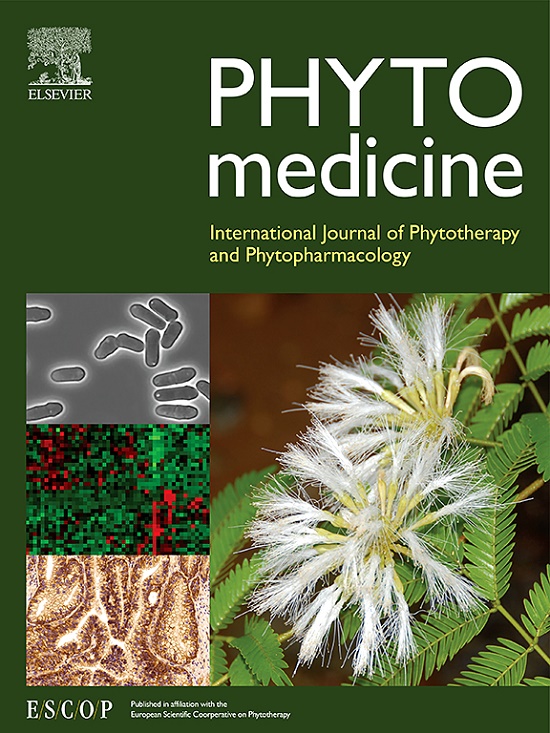Luteolin inhibits inflammation and M1 macrophage polarization in the treatment of Pseudomonas aeruginosa-induced acute pneumonia through suppressing EGFR/PI3K/AKT/NF-κB and EGFR/ERK/AP-1 signaling pathways
IF 6.7
1区 医学
Q1 CHEMISTRY, MEDICINAL
引用次数: 0
Abstract
Background
The opportunistic pathogen Pseudomonas aeruginosa primarily causes infections in immunocompromised individuals. Luteolin, a natural flavonoid, is widely present in plants, which exerts various pharmacological activities, including anti-inflammatory and antimicrobial activities.
Purpose
This study aimed to explore the therapeutic efficacy of luteolin and the underlying molecular mechanisms in treating the P. aeruginosa-induced acute pneumonia.
Methods
Network pharmacology was utilized to identify the core targets of luteolin for treating acute P. aeruginosa pneumonia. Gene Ontology (GO) and Kyoto Encyclopedia of Genes and Genomes (KEGG) enrichment analysis were performed to dissect the potential effects of luteolin and the involved signaling pathways. Surface plasmon resonance (SPR) assay and molecular docking were employed for studying the binding affinities of luteolin with the key targets. Furthermore, we applied a mouse model of bacterial pneumonia for assessing the therapeutic effects of luteolin in vivo, and an in vitro infection model for specifically investigating the effects of luteolin on macrophages as well as the underlying mechanisms upon P. aeruginosa infection.
Results
Network pharmacology identified TNF, IL-6, EGFR and AKT1 as the key targets of luteolin for treating acute P. aeruginosa pneumonia. Moreover, as revealed by GO and KEGG enrichment analysis, EGFR, MAPK and PI3K/AKT pathways were the potential pathways regulated the P. aeruginosa-induced inflammatory response. According to the in vivo results, luteolin effectively mitigated the P. aeruginosa-induced acute lung injury through reducing the pulmonary permeability, neutrophil infiltration, proinflammatory cytokine production (IL-1β, IL-6, TNF and MIP-2) and bacterial burden in lung tissues, which led to increased survival rate of mice. Furthermore, the luteolin-treated mice had diminished EGFR, PI3K, AKT, IκBα, NF-κB p65, ERK, c-Jun and c-Fos phosphorylation, down-regulated M1 macrophage marker levels (iNOS, CD86 and IL-1β) but up-regulated M2 macrophage marker levels (Ym1, CD206 and Arg1) in lung tissues. Consistently, the luteolin-pretreated macrophages exhibited reduced phosphorylation of these regulatory proteins, diminished proinflammatory cytokine production, and down-regulated expression of M1 macrophage markers, but up-regulated expression of IL-10 and M2 macrophage markers.
Conclusion
luteolin effectively suppressed the inflammatory responses and M1 macrophage polarization through inhibiting EGFR/PI3K/AKT/NF-κB and EGFR/ERK/AP-1 signaling pathways in the treatment of acute P. aeruginosa pneumonia. This study suggests that luteolin could be a promising candidate for development as a therapeutic agent for acute bacterial pneumonia.

木草素通过抑制EGFR/PI3K/AKT/NF-κB和EGFR/ERK/AP-1信号通路抑制炎症和M1巨噬细胞极化治疗铜绿假单胞菌诱导的急性肺炎
机会致病菌铜绿假单胞菌主要引起免疫功能低下个体的感染。木犀草素是一种天然的类黄酮,广泛存在于植物中,具有多种药理活性,包括抗炎和抗菌活性。目的探讨木犀草素治疗铜绿假单胞菌所致急性肺炎的疗效及其分子机制。方法利用网络药理学方法鉴定木犀草素治疗急性铜绿假单胞菌肺炎的核心靶点。通过基因本体(GO)和京都基因与基因组百科全书(KEGG)富集分析,剖析木犀草素的潜在作用及其相关信号通路。采用表面等离子体共振(SPR)技术和分子对接技术研究木犀草素与关键靶点的结合亲和力。此外,我们应用小鼠细菌性肺炎模型来评估木犀草素在体内的治疗效果,并应用体外感染模型来专门研究木犀草素对巨噬细胞的影响及其对铜绿假单胞菌感染的潜在机制。结果网络药理学鉴定木木素治疗急性铜绿假单胞菌肺炎的关键靶点为TNF、IL-6、EGFR和AKT1。此外,GO和KEGG富集分析显示,EGFR、MAPK和PI3K/AKT通路是铜绿假单胞菌诱导的炎症反应的潜在调控通路。体内实验结果显示,木犀草素通过降低肺通透性、中性粒细胞浸润、促炎细胞因子(IL-1β、IL-6、TNF和mmp -2)的产生和肺组织细菌负担,有效减轻了铜绿假单胞菌诱导的急性肺损伤,从而提高了小鼠的存活率。此外,木黄素处理小鼠肺组织中EGFR、PI3K、AKT、i -κB α、NF-κB p65、ERK、c-Jun和c-Fos磷酸化降低,M1巨噬细胞标志物(iNOS、CD86和IL-1β)水平下调,M2巨噬细胞标志物(Ym1、CD206和Arg1)水平上调。一致地,木犀草素预处理的巨噬细胞表现出这些调节蛋白磷酸化降低,促炎细胞因子产生减少,M1巨噬细胞标志物表达下调,但IL-10和M2巨噬细胞标志物表达上调。结论木草素通过抑制EGFR/PI3K/AKT/NF-κB和EGFR/ERK/AP-1信号通路,有效抑制急性铜绿假单胞菌肺炎的炎症反应和M1巨噬细胞极化。本研究提示木犀草素作为急性细菌性肺炎的治疗药物有很大的发展前景。
本文章由计算机程序翻译,如有差异,请以英文原文为准。
求助全文
约1分钟内获得全文
求助全文
来源期刊

Phytomedicine
医学-药学
CiteScore
10.30
自引率
5.10%
发文量
670
审稿时长
91 days
期刊介绍:
Phytomedicine is a therapy-oriented journal that publishes innovative studies on the efficacy, safety, quality, and mechanisms of action of specified plant extracts, phytopharmaceuticals, and their isolated constituents. This includes clinical, pharmacological, pharmacokinetic, and toxicological studies of herbal medicinal products, preparations, and purified compounds with defined and consistent quality, ensuring reproducible pharmacological activity. Founded in 1994, Phytomedicine aims to focus and stimulate research in this field and establish internationally accepted scientific standards for pharmacological studies, proof of clinical efficacy, and safety of phytomedicines.
 求助内容:
求助内容: 应助结果提醒方式:
应助结果提醒方式:


